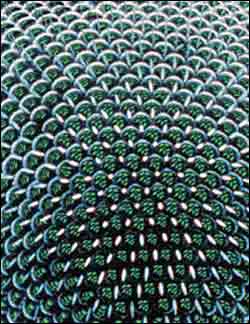Scientists link another gene to degenerative blindness

A highly magnified view of a fruit fly’s eye.
Researchers have labored for decades to understand blindness-inducing neurodegenerative diseases such as age-related macular degeneration (AMD) and retinitis pigmentosa (RP).
It has been a painstaking scientific journey as AMD and RP each belong to a complex family of disorders, in which every disorder has many forms and each form is encoded with a distinct genetic recipe. Even AMD, a major cause of vision loss in people over 60, is actually a collection of more than 50 diseases.
Now, a team of researchers at the University of Wisconsin-Madison has taken a small but crucial step forward in the ongoing fight against retinal degeneration. Working with fruit flies, the scientists have discovered that a mutation in a common gene called calnexin can derail the light-processing activity of cells and set in motion the gradual breakdown of vision. They report their findings today in the journal Neuron.
Calnexin-found in both fruit flies and humans-functions as a cellular chaperone, ensuring that proteins “fold” or orient properly and get to the parts of the cell they need to go. It also modulates calcium levels, which is critical for proper vision.
When calnexin goes awry, however, calcium levels build up and the proteins that depend on it malfunction, says senior author Nansi Jo Colley, a medical geneticist at the UW-Madison departments of ophthalmology and genetics, and an affiliate of the Eye Research Institute.
At a time when more than 103 genes are known to be involved with AMD and RP, the UW-Madison work could one day help doctors deliver tailor-made treatments to patients who specifically carry calnexin mutations. Because the calnexin protein and other chaperones are also present in the brain, the work can help to answer broader questions about neurodegenerative disease, Colley adds.
“Understanding the basic mechanisms of how proteins are folded holds the key to finding treatments for not only retinal degenerative diseases but also other neurodegenerative diseases such as Alzheimer’s, Huntington’s and Parkinson’s.”
To detect the calnexin mutation, the UW-Madison team used genetic mapping to zero in on the exact region harboring the mutant. Subsequent DNA sequencing of that target area pinpointed calnexin as the culprit gene, explains lead author Erica Rosenbaum, a researcher in Colley’s laboratory.
Colley plans to continue searching for other genetic mutations that might help trigger retinal degeneration. “The more mutations we identify the easier it will be to step back and look at the big picture of the general principles of neurodegeneration,” she says.
Media Contact
More Information:
http://www.wisc.eduAll latest news from the category: Life Sciences and Chemistry
Articles and reports from the Life Sciences and chemistry area deal with applied and basic research into modern biology, chemistry and human medicine.
Valuable information can be found on a range of life sciences fields including bacteriology, biochemistry, bionics, bioinformatics, biophysics, biotechnology, genetics, geobotany, human biology, marine biology, microbiology, molecular biology, cellular biology, zoology, bioinorganic chemistry, microchemistry and environmental chemistry.
Newest articles

Bringing bio-inspired robots to life
Nebraska researcher Eric Markvicka gets NSF CAREER Award to pursue manufacture of novel materials for soft robotics and stretchable electronics. Engineers are increasingly eager to develop robots that mimic the…

Bella moths use poison to attract mates
Scientists are closer to finding out how. Pyrrolizidine alkaloids are as bitter and toxic as they are hard to pronounce. They’re produced by several different types of plants and are…

AI tool creates ‘synthetic’ images of cells
…for enhanced microscopy analysis. Observing individual cells through microscopes can reveal a range of important cell biological phenomena that frequently play a role in human diseases, but the process of…





















